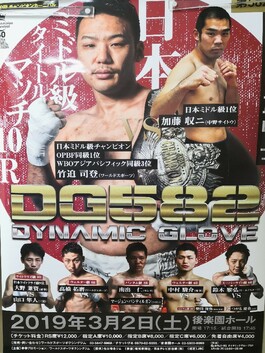 The Japanese Middleweight scene isn't known as something too exciting, but right now it's probably as interesting as it's ever been. There's a relative lack of depth, and very few really interesting bouts to be made, but those top domestic level bouts are really interesting match ups. One of the fighters that really does standout as a must watch fighter on the domestic scene is national Middleweight champion Kazuto Takesako (10-0, 10), who will be looking to make his second defense on March 2nd, when he takes on mandatory challenger Shuji Kato (10-1-1, 6). For Kato this will be his first title fight, but also a huge step up in class for him. Takesako is from the World of Sport Boxing Gym, the same gym as the recent world title challenger Takeshi Inoue. He turned professional back in 2015 and rose through the ranks quickly, whilst leaving destruction behind him. His first 6 bouts took place over 21 months and saw him need just 12 rounds to stop all 6 foes. Those wins lead to him getting a Japanese title eliminator in late 2017, and he made the most of his opportunity as he blasted out Shoma Fukumoto in the opening round. That win lead to him facing Japanese champion Hikaru Nishida in early 2018, and Nishida was also blasted out inside a round. Since the winning Takesako has fought twice. His first opponent following his title win was tough Thai Chaiwat Mueanphong, who managed to survive into the 7th round with Takesako before eventually succumbing to his power. He then defended his title against a game and aggressive Sanosuke Sasaki, who came to win but was stopped in the second round. Takesako is, as he record suggests, a big puncher. His power is legitimate and when he lands clean he hurts fighters. He has devastating blows to both head and body and surprising hand speed for such a puncher. Where he perhaps looks limited is in terms of his naturally size, he's only about 5'10" which is tiny for a Middleweight, and in his recklessness. When he feels he has his man hurt he can leave himself a little bit too open. Another issue is his defense is quite basic. He's essentially a puncher-boxer, who appears to be able to take a shot as well as landing his own dynamite leather. Whilst Takesako has been on our radar for a while the same can't really be said of the 28 year old challenger. Kato, a southpaw from Tokyo, made his debut in December 2014 fighting just above the Super Middleweight limit, stopping his foe inside a round. He would drop down in weight for his second bout, in July 2015, and take a decision win. After having won his first 2 bouts Kato would suffer his first loss, being taken out by Altin Pepa in September 2015. His return to the ring would also end in disappointment as he was held to a draw by Agoo Masaru. Since that draw however, Kato has built himself a decent record, winning his last 8 bouts. Those 8 bouts have sene him being crowed the 2017 Middleweight Rookie of the Year, and becoming the mandatory for the Japanese title, following a split decision win over Hikaru Nishida last November, in what is by far and away his best win to date. Watching footage of Kato we see a rangy fighter, who uses his lead hand to control distance, pawing at his opponent, moving backwards and trying to lure opponents in. It's not a pretty style, but it is an effective one at the lower levels. When he comes forward he doesn't appear to have much power on his shots, but they are thrown from some awkward angles. His technique often looks really poor, bug his size seems to allow him to get a real amount of weight behind his blows, which do do damage. Whilst Kato has been having success, and will tower over Takesako, we really don't see what he has to offer when he goes up against Takesako. We suspect that Kato will manage to frustrate and annoy the champion, but won't be able to get Takesako's respect. We expect to see the champion begin to slip the lead hand of Kato and then pound away on the inside, stopping the challenger in the first 3 or 4 rounds, depending on how tough Kato is, and how well he can survive the power of the champion.
0 Comments
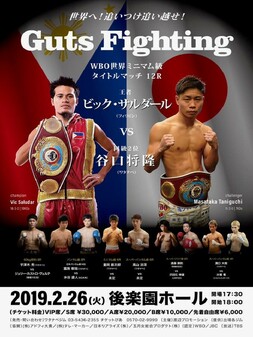 On February 26th we'll see Vic Saludar defending his WBO Minimumweight title against Masataka Taniguchi. That main event is a brilliant match up, but it's not the only interesting bout on the card, with the talented southpaw Fumiya Fuse (7-0, 1) taking on Naoto Mizutani (5-5-1, 2) in a solid match up and a good step forward for Fuse. Aged 20 Fuse is one of the many talented youngsters making a mark at the Watanabe Gym. He turned professional at the age of 18, debuting back in January 2017, and would go on to win the 2017 All Japan Rookie of the Year at Bantamweight. In 2018 Fuse would give his reputation a boost, beating Indonesian Yohanis Tatul in May before travelling over to Korea and schooling Dong Young Lee in Daejeon. That win over Lee really showed what an exceptional young fighter Fuse was. For those who haven't seen Fuse in action before he is a quintessential boxer, with a sharp jab, great ring control, smart footwork and accurate punching. He's got lovely timing, smart defense and a fantastic ability to judge distance. It's his ability to find the right shot that really impresses, given he's such a youngster and such a novice. He can often see shots that much, much more experienced fighters wouldn't see, and he looks like the sort of fighter who knows how to open up an opponent with both his offense and his defense. Sadly however he really does lack power and he doesn't appear to be able to hurt fighters, which is a shame as that is the only thing missing. We've got our fingers crossed in the hope that as he physically matures he will develop his power and manage to add a bit of bang on to his punches. At 29 years old Mizutani has had a career that had faltered a fair bit, with as many defeats as wins. Despite suffering a number of losses it should be noted that he has typically faced stiff competition, with his defeats coming to the likes of Kenshin Oshima, Ryota Ishida and Ryo Akaho, among others. As for his wins, the most notable was a 2018 win over 2017 All Japan Super Flyweight Rookie of the Year Mirai Imagawa. Like Fuse he's a southpaw, and in fact he will only be the second southpaw Fuse will have faced, and his first since debut opponent Shinnosuke Hasegawa more than 2 years ago. Watching footage of Mizutani, thanks to the excellent Boxing Raise service, we see a really basic fighter. Mizutani will come forward behind a rather slapping looking jab, often over reaching and leaving himself open to counters. His left seems to have more snap to it than his jab, but he seems to telegraph the shot quite a bit and looked like he is there to be countered when he throws it. Again Fuse he may not been punished by power shots, but he will be tagged by clean shots for those mistakes. Given the flaws with Mizutani it's hard to see him offering too much, technically, to test Fuse, though what he will do is test Fuse's ability against a fellow southpaw and his stamina over 8 rounds. Fuse's a fantastic little boxer, and we'd be very surprised by anything other than a clear win for the youngster, though this will be a good way to see how he looks, and a good step towards a potential Youth title fight later in the year. 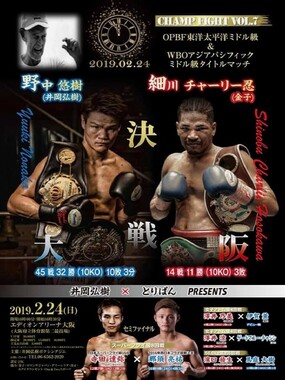 The Middleweight scene is not one that we tend to think of too much when we discuss Japanese fighters, even with the recent success of Ryota Murata. Strangely however the Japanese scene at 160lbs is probably as good as it's ever been, with several exciting fighters making their mark. Those include Japanese Middleweight champion Kazuto Takesako as well as the unified OPBF and WBO Asia Pacific champion Shinobu Charlie Hosokawa (11-3, 10). Hosokawa won the unified title last year in a Japanese Fight of the Year candidate against Yasuyuki Akiyama, avenging one of his losses in the process, and will be making his first defense this coming Sunday against skilled veteran Yuki Nonaka (32-10-3, 10), on February 24th. The bout will be pitting Hosokawa's aggression, power and tenacity, against Nonaka's skills, experience and toughness, in what could be the surprise bout of the week. Aged 34 the hard hitting Hosokawa, who is the brother of Japanese Light Welterweight champion Valentine Hosokawa, made his debut in 2014, at the age of 29. He would lose on his debut and would actually lose 2 of his first 4 bout, both by razor thin decisions. Following those set backs he reeled off 4 straight stoppage wins before losing another close contest, that time to Yasuyuki Akiyama, the man he would later rip the two regional titles from. Following the loss to Akiyama we saw Hosokawa improve, showing his stamina with an 8th round TKO over Kazuyuki Fukuyama and a 7th round TKO over Hisao Narita, and earn a second bout with Akiyama last September. After beating Hososkawa, by majority decision, Akiyama had shocked the regional scene with a TKO win over Koki Tyson for the OPBF and WBO Asia Pacific titles. Hosokawa would end that reign by winning a war with Akiyama last year, stopping Akiyama in the 11th round. The fight started slowly but warmed into a real action packed contest, as Hosokawa began to march Akiyama down and broke him down with powerful shots. The performance showed the good, and the bad, of Hosokawa. He's aggressive, heavy handed, has a high work rate and is a very powerful and strong fighter. Defensively however he is open, he is predictable and he's not quick. He often marches forward looking to cut the distance usually comes forward in straight lines, something that someone with the skills and experience of Nonaka may be able to expose. Despite being predictable he doesn't seem to know how to take a backwards step and has proven to be almost impossible to dissuade from coming forward. The 41 year old Nonaka is an old school veteran, having made his debut way back in 1999 as a Welterweight. He would fight as low as Light Welterweight before really settling on Light Middleweight. Early in his career he struggled to find his place and his style in the sport, losing 2 of his first 3, 3 of his first 5 and 4 of his first 9, including a KO loss to Masahiro Muroya. Amazingly after that stoppage loss, back in 2002, Nonaka has never been stopped in 36 subsequent contests! Despite settling at Light Middleweight Nonaka would struggle to have major success, losing in his first title fight in 20078, when he was out pointed by Kazuhiko Hidaka in an OPBF Light Middleweight title fight. The following year he would take the Japanese Light Middleweight title with a win over Akihiro Furukawa. He would later go on to unify the Japanese and OPBF titles before losing both belts to Akio Shibata in 2009. That loss was a temporary set back and in 2014 he would become a 2-time Japanese champion, schooling Kengo Nagashima for the national title, which he held until 2017 and made 6 defenses of. Sadly since vacating the belt Nonaka has gone 1-2, with losses to Dennis Hogan and Takeshi Inoue in world title eliminators. Despite his age Nonaka is a criminally under-rated fighter. He lacks power but is surprisingly quick, an ultra sharp fighter who uses his jab to spear fighters, at range, lays traps with intelligent footwork and varies his shots amazingly well. His uppercut seems to find the target far too easily at times and he always looks so comfortable and relaxed in the ring. He's the sort of fighter that any young kid picking up the sport should take a look at. Sadly, for him, his lack of work rate, and his counter punching tendencies can see him fail to get the respect of fighters and being out worked by hungrier fighters. Also, notably for this fight, he will be in with a dangerous and natural Middleweight, something he hasn't typically faced, having fought mostly at Light Middleweight. He has dipped his toe at Middleweight, but not against someone with the power and physicality of Hosokawa. Whilst we know this bout will go under the radar, especially coming just days before the mouth watering WBO Minimumweight title bout between Vic Saludar and Masataka Taniguchi, this has the potentially to be brilliant. Hosokawa's head first aggression should play into Nonaka's hands, and give the veteran a lot of openings. Nonaka however won't have the power to get Hosokawa's respect and we'd expect him to be willing to take 3 to land 1 as a result. This should result in a brilliant, mid range war with Nonaka easily out landing his man but being tagged by the bigger shots. If Nonaka's chin can hold up he probably takes the win, but that is a huge if, and we wouldn't be surprised by Hosokawa getting to him late to force a stoppage. Either way we are in for a treat! 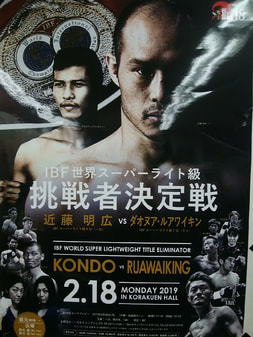 On February 18th we'll see an IBF Light Welterweight world title eliminator, as Japan's insanely tough Akihiro Kondo (31-7-1, 18) takes on rising Thai hopeful Downua Ruawaiking (14-0, 11), also known as Apinun Khongsong. The bout, will take place at the Korakuen Hall as the headline bout of an "A-Sign Bee" show, and promises a lot. Kondo is best known outside of Japan for one bout, his 2017 contest with Sergey Lipinets for the IBF title. That bout saw Kondo take Lipinets the distance, and surprisingly actually fight pretty evenly with the Kazakh born American based Russian. What fans perhaps weren't aware of is that before that bout Kondo was a notable name on the Japanese scene, having debuted back in 2006. He had won the 2007 Rookie of the Year at Lightweight, claimed the Japanese Lightweight in 2009 and had been a featuring in the national title scene until 2013. He then had a short retirement before bouncing back and rebuilding his career to the point where he won the WBO Asia Pacific Light Welterweight title and earned an IBF title fight. Against Lipinets we saw Kondo prove his was tough, had good stamina and under-rated boxing skills. He took solid blows from Lipinets and never looked hurt, whilst managing to put pressure on to the highly fancied Lipinets. That toughness is something we've seen right through his career, a career that has had ups and downs but certainly appears to have contributed to a solid fighter. In the ring Kondo is consistent, he's someone who will typically fight at a good pace, and will pressure through out, mixing up the pressure with intelligent punching. Although not a puncher he's gone 7-1 (7) in his last 8, and has certainly developed more belief in his power in recent years. At the age of 22 Downua looks like he is one of the next rising stars of the Thai scene. He made his debut in June 2016 and moved his way up the regional scene, beating Heri Andriyanto in December 2016 Adam Diu Abdulhamid in August 2017 and most recently Sonny Katiandagho in December 2018. Although still a relative novice in professional boxing it's clear he's a very talented fighter, with heavy hands and impressive composure, having taken almost invited pressure from Katiandagho so that he could counter. He looks a more natural fighter than someone like Teerachai Kratingdaenggym, but this is by far his biggest test. Although fighting at 140lbs Downua looks a big fight. He's not far off being 6' tall and has a long reach, which likely helps him generate his power. He's a blunt puncher with heavy hands, but a sharp puncher, with scything shots that catch opponents clean. He's also a relaxed looking fighter, with nice movement, under-rated speed and real accuracy. He's the sort of fighter you would see typically Thai team padding the record of, letting him develop slowly and building a good record, but for some reason he's being taken a different direction, potentially from a team that has learned that fighters can regress with too many mismatches. Saying that there are mistakes, especially when it comes to his defense and the way he drops his hands, but it seems likely that as he takes on better competition those mistakes will be tidied up, and against Kondo we expect him to be fighting smartly. The big question here is whether the bout is coming too soon for Downua. At the age of 22 he is still a boxing baby and has only had 14 fights, accounting for 55 rounds. If Downua has got the stamina for 12 rounds, can keep his fluidity and speed through out then he has a real chance to upset the Japanese veteran. The reality however isn't that simple and we suspect the experience and determination of Kondo will prove to be too much, at this early stage, for the Thai. We're predicting a late stoppage win for Kondo, perhaps even whilst he's down on the cards. 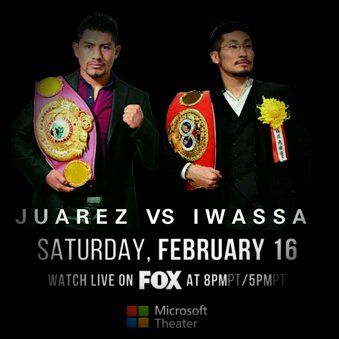 One of the best looking bouts in February is set for February 16th and will see former world champion Ryosuke Iwasa (25-3, 16) take on Mexican brawler Cesar Juarez (23-6, 17) in what is a must win for both men. The bout, an IBF Super Bantamweight world title eliminator, will be Iwasa's first bout since losing the IBF title last year to TJ Doheny whilst Juarez will be looking to score his 4th win since losing to Isaac Dogboe in January 2018. The 29 year old Iwasa was tipped as one to watch from the moment he turned professional, back in August 2008. He raced towards a title fight and less than 3 after his debut he fought for the Japanese Bantamweight title, losing in the 10th round to Shinsuke Yamanaka. He would win the title 8 months later, beating Jerope Mercado for the then vacant title. He would defend that belt until winning the OPFB Bantamweight title and moving onto a world fight. Sadly for Iwasa he would lose in his first world title fight, being stopped in 6 rounds by Lee Haskins. That loss saw Iwasa move up in weight and in 2017 he claimed the IBF Super Bantamweight title in impressive fashion, stopping Yukinori Oguni in 6 rounds. Holding a title usually brings out the best in a fighter, but that wasn't the case for Iwasa, who defended the belt once, in a poor performance against Ernesto Saulong, before losing the title to Doheny in August 2018. At his best Iwasa is a hard hitting boxer-puncher, with a venomous straight left hand. Sadly however he is one paced, inconsistent and really struggles with fellow southpaws, with all 3 of his losses coming against other lefties. We've rarely seen Iwasa at his best, and that's a shame. He's also lacking in terms of speed and rarely shows full intensity in the ring. Whe things click however he is fantastic and we'd love to see more of Iwasa at his best. Aged 27 Juarez is a Mexican warrior who should be in his physical prime. Sadly however he has had a very hard career and he may well be on the slide just a touch earlier than he should be. He won 12 of his first 13, 11 by stoppage, with his sole early defeat being a disqualification to Edgar Lozano. A close loss to Hugo Partida hardly slowed him down and in 2015 he would score back to back wins over Cesar Seda and Juan Carlos Sanchez to earn a shot at the vacant WBO Super Bantamweight title. At the time only in Mexico knew who Juarez was but his title fight, against Nonito Donaire, opened the boxing world to the stubborn, aggressive, tough and rugged Juarez. The Mexican was dropped twice in round 4, but went on to push Donaire all the way in what ended up being a really tough test for the Filipino. The loss to Donaire was followed by a surprise decision loss to Giovanni Delgado before he strung together 3 notable wins over Filipino fighters, including an 8th round KO over Albert Pagara and a thrilling decision win over Richard Pumicpic. That winning run lead to a fight with Isaac Dogboe, who stopped Juarez in 5 rounds, and since then he has scored 3 wins. In the ring Juarez is a rugged, heavy handed, come forward fighter. He's not the most highly skilled, or physically imposing, but he is an exciting and aggressive fighter, who really does take a great shot and has real grit. He also seems to get stronger in the later rounds of the fight, which is a worry for most fighters, as Donaire found out. If Iwasa can put it on, fight to his best, and make the most of his damaging left hand, he can win this, and make a success US debut. He is however 0-1 outside of Japan, and 1-1 outside of Tokyo, and will be coming into this after 6 months away and with question marks about whether he even wants to box any more. Juarez's style is a nightmare for a puncher, unless they can really take him out. Sadly for Iwasa we actually see Juarez being in his face, crushing the distance and breaking him down up close. We'd love to see Iwasa win and earn another world title fight, but we see this as an horrific style match up for Iwasa, who will need to land, and land hard, when Juarez comes in. It's not impossible for Iwasa to take the victory, but it will be a very big ask of the Japanese fighter, who should be considered the under-dog here. 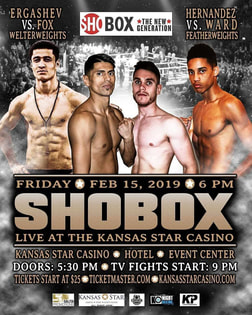 The Uzbeks are well and truly coming. Last year we saw so many Uzbek fighters leave a mark on the sport and it seems almost certain that 2019 will be an even bigger year for Uzbek boxers. One of those who impressed last year was heavy handed Light Welterweight hopeful Shohjahon Ergashev (15-0, 14), who went 5-0 (4) during a huge year for his career. He will be looking to build on his growing reputation this year, and will be returning to the ring on February 15th to take on fellow unbeaten Mykal Fox (19-0, 5), in what looks like a mouth watering match up. Ergashev really made his mark at the start of 2018, when his bout with Sonny Fredrickson was televised. Not only was it televised but it ended with Ergashev scoring a 3rd round TKO win over Fredrickson in what turned out to be a show case for the exciting Uzbek, who quickly got compared to Naseem Hamed. That win saw Ergashev move to 11-0 (11), however his perfect stoppage run would come to an end 3 months later, when Wang Zhimin survived 10 rounds with Ergashev, who took a wide decision win. Following that bout Ergashev would go on to score 3 wins, the final of which saw him taking out Nazareno Gaston Ruiz in 18 seconds in December. Ergashev, like many of the top Uzbeks breaking through the ranks right now, is extremely heavy handed, aggressive, exciting and has a rawness to him. Technically he can be good, but he's more of an unorthodox southpaw than a text book fighter, and is someone who clearly knows he hits hard. There is a lot more to him than just his power, and the comparisons to Naseem Hamed seem to be based around his unorthodox boxing, but we dare say we've not seen how good Ergashev really is. When he gets pushed we're likely to see a lot more form him and it might even be fair to suggest we've not seen him move beyond third gear yet. At 6′ 3½″ the 23 year old Fox is a huge Light Welterweight, and will have size advantages over pretty much anyone he faces. He's around 5" taller than Ergashev and like the Uzbek he's also a southpaw, and lets be honest no one likes fight tall, rangy southpaws. Despite his young age he has been a professional for close to 5 years, having made his debut in April 2014. Since his debut he has faced a mixture of limited competition, fellow hopefuls and a veteran, name DeMarcus Corley. On paper the win over Corley, which came last year against a 44 year old Corley, is his best to date. Sadly it was also a close win, over a guy who is over a decade removed from his prime. Fox usually towers over opponents and uses a nice crisp jab, making the most of his rach and speed to control fights. Whilst he does have an excellent jab his straight left hand does look slow and predictable, he seems to lack power in his power shots and that will be a problem in making a fighter like Ergashev give him any respect. He does have nice movement and good foot speed, to go with his jab, but there is a big difference between nice movement and the type of movement needed to last with someone like Ergashev. We suspect that Fox will look to box behind his long levers, get the crisp jab in the face of Ergashev and box at range.Sadly for him Ergashev will have different plans and won't care too much about the jab of Fox, instead he will be looking to steam roll the American and we suspect that he'll find than easier than many will expect. We wouldn't be surprised, at all, if Ergashev stops Fox inside 5 rounds, and takes another step towards a potential world title fight. 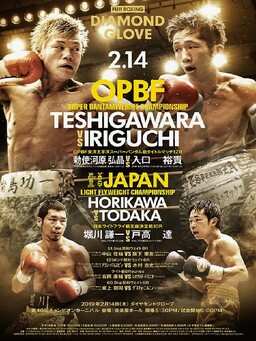 The Light Flyweight division is one of the most interesting, with so many amazing fighters at the top of the division. It's perhaps not got the huge amounts of attention of some other divisions, but it is a brilliant weight class, for us the best in the sport right now. At the end of 2018 Tetsuya Hisada vacated the Japanese title, to pursue a world title fight, and is expected to face Carlos Canizales later this year. With Hisada vacating, rather than face mandatory challenger Kenichi Horikawa (38-15-1, 12), we'll see Horikawa battle against Satoru Todaka (9-2-4, 3) to crown a new champion, with that bout taking place on February 14th at the Korakuen Hall. Horikawa earned his shot by winning an eliminator back in October, stopping Koji Itagaki. On paper that win over Itagaki had set up a 4th clash with Hisada, before Hisada chose to vacate and chase a world title fight, giving Horikawa a shot at the vacant title. The 38 year old Horikawa, who debuted way back in 2000, is a true veteran of the ring with 54 fights. Despite suffering 15 losses in his 54 bouts Horikawa has truly fought a who's who, including Akira Yaegashi, Florante Condes, Edgar Sosa, Ryuji Hara, Noknoi CP Freshmart, Yu Kimura, Shin Ono, Kenshiro and the aforementioned Hisada. He typically comes up short against the top tier fighters, but did stop Shin Ono, holds 2 wins over Hisada and gave hell to Kimura and Kenshiro. Despite being 38 Horikawa has a really good energy and work rate. He comes forward a lot, uses decent upper body movement to apply pressure and looks to force a fight. Despite being an offensively minded fighter Horikawa is smart with his pressure and limits his output at times, trying to draw mistakes and get inside. His jab and hook are not what they once were in terms of speed, but he does have good timing and does enjoy having a fight. If, or when, he gets inside he can make things violent and rough, and that's when he's at his best, picking up the work rate and grinding people down. Todaka is a bit more of an unknown. The 29 year old made his debut back in 2014, losing to Yukiya Hanabusa, and hasn't really scored any wins of note. What he has done however is proven very tricky to beat, with only Hikaru Ota stopping Todaka. The loss to Ota actually tells us quite a lot about Todaka, who has adjusted his style since that defeat. Against Ota we saw Totaka get into a war, standing and trading and looking to go blow for blow with a pretty underrated fighter. Those blows resulted in a nasty cut that forced the doctor to stop the bout. Although Todaka's style has changed slightly he is still, for all intents, an aggressive fighter, who comes forward and throws a pretty decent volume of shots. He's not particularly heavy handed, quick or accurate, but he's aggressive, looks strong and pressures opponents on to the back fighter behind his guard and footwork. Sadly for Todaka it looks like his style is made to order for Horikawa, who very much a better version of Todaka. Both press the action both enjoy a war up close and both let their hands in range. Sadly for Todaka we can't see how he wins a war with Horikawa, who hits harder, is more experienced in that type of bout and physically stronger. If Todaka can instead use his younger legs, move in and out more and not try to march Horikawa down he has a chance, but the reality is that we see Todaka fighting Horikawa's fight, and losing. If we're right it would see Horikawa become a 2-time national champion, and potentially put himself in the mix for a bigger bout down the line. If Todaka can however shock us, he'll have a number of domestic fighters snapping at his heels for a title shot later in the year, such as Ryuto Oho or Taku Kuwahara. 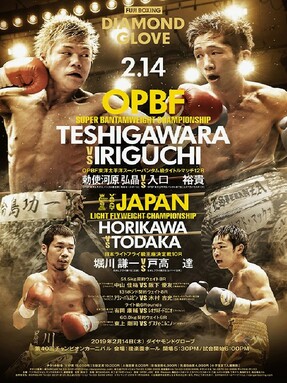 On February 14th we'll get the chance to see OPBF Super Bantamweight champion Hiroaki Teshigawara (18-2-2, 11) battle against Yuki Iriguchi (10-2-1, 4), in what will be Teshigawara's first defense of the title that he won in October 2018. The bout could, potentially, push Teshigawara into a world title shot, following the likes of Ryohei Takahashi who lost recently to TJ Doheny, or could put Iriguchi on the boxing map. Incidentally Iriguchi does actually hold a win over the aforementioned Takahashi. Over the last 2 years we've seen Teshigawara become one of the must watch Japanese fighters at 122lbs. In late 2016 he gave Ryo Akaho a really close bout, putting himself on the map, and since then he has gone 6-0 (5), claiming the WBO Asia Pacific Bantamweight title and the OPBF Super Bantamweight title. On paper that's pretty impressive, but when you consider that his wins have come against the likes of Keita Kurihara, Jason Canoy and Teiru Kinoshita you see it's more than just record padding from Teshigawara. In fact he has been facing top domestic and regional talent and showing that he's an excellent, exciting and aggressive fighter. In the ring Teshigawara is more a brawler than a boxer. There are boxing fundamentals there but he does seem to enjoy a war, believing in his power and toughness to break opponents down. That has been working, against power puncher, speedy fighters and tough fighters, though it didn't against Canoy who managed to survive Teshigawara's power to give us a brilliant 12 round war. He's tough, strong and powerful, a real nightmare for most at this level, though he will need to develop his boxing skills if he's to beat top 10 competition. At 21 years old Iriguchi is a relative boxing baby, and is 7 years younger than the champion, though debuted just weeks after his 17th birthday. He would win his first 6 bouts before suffering back to back setbacks with a loss to Hibiki Jogo and a draw against Noboru Osato. Since then he has proven to be a thorn in the side of more highly regarded domestic opponents. He would be the touted Kenshin Oshima in 2016, add Takahashi's scalp in 2017 and defeat Takafumi Nakajima in 2018. His only loss, other than the one to Jogo, was a razor thin split decision to the big hitting Takuya Mizuno in late 2017 in what was a Japanese Youth title fight in Mizuno's backyard. Iriguchi is much less of a puncher than Teshigawara and is much more a boxer, with a volume punching style. He's got a solid right hand, a good work rate and applies good pressure. Sadly though he is defensively very open, not the quickest fighter out there and he looks pretty 1-handed, often launching right hands without setting things up with a jab. Watching what is available of Iriguchi shows him to be almost the sort of fighter that a fan would want to see Teshigawara to face off with. He's aggressive, flawed and comes forward. Against Teshigawara that should make for a very exciting, back and forth brawl. Sadly for Iriguchi however it seems like the significant edge in power will be the difference and Teshigawara will eventually break down the challenger, likely in the later rounds of an all out thriller! 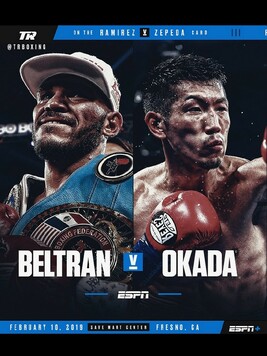 By - George Delis (@Delisketo) On February 10, undefeated Japanese star Hiroki Okada faces former World champion Raymundo Beltran in a WBC Eliminator. Hiroki Okada (19-0/13 KOs), one of the brightest Japanese boxing stars of this generation, is currently ranked at the top 10 of the Super Lightweight division. Competing in the sport since his high school days, as an amateur, he won the National Sports Festival Tournament (Japan’s premier sporting event) twice, before turning pro. Going 7-0 (all stoppages) prior to winning the Japanese title, Okada defended this legendary championship 6 times, from 2014 to 2016, against Koichi Aso (23-8) twice, Hayato Hokazono (18-5), Masanobu Nakazawa (18-2), Cristiano Aoqui (13-7) and Valentine Hosokawa (24-6), which proved to be his toughest at the time, as Hosokawa was a much stronger fighter than him. Despite taking a beating, he still managed to come out on top. As Okada was moving up in the rankings, he began facing international competition and on December of 2017, he faced Jason Pagara (41-3) for the vacant WBO Asia Pacific title. A long-time WBO International champion, the Filipino fighter was undefeated since 2011 and with only two decision losses in his entire career. Okada kept peppering him with left jabs (a key weapon to his arsenal) and eventually connected with an uppercut in the sixth round, which left him unable to respond to the referee’s count, giving Pagara his first stoppage loss and himself the strap. After dispatching world title contender Ciso Morales (19-8) in just the first round (same strategy as in the Pagara bout, only this time he dropped him with a counter right hook) Okada signed with Top Rank and made his US debut this past September against Cristian Rafael Coria (28-7). It’s worth mentioning that Okada has been training at the Kadoebi Houseki Boxing Gym, a gym that has produced many champions like WBC Strawweight World champion Eagle Kyowa, WBC & Lineal Flyweight World champion Koji Kobayashi, IBF Super Bantamweight World champion Yukinori Oguni, WBA Lightweight World champion Yusuke Kobori and unified Japanese, OPBF & WBO Asia Pacific Heavyweight champion, as well as K-1 champion, Kyotaro Fujimoto. Okada will need to be at his best when he takes on “Sugar” Ray Beltran, for a chance at the WBC World title. The 20 year veteran Raymundo Beltran (35-8/21 KOs) finally won the World championship last year, at 36 years of age. The road to the gold wasn’t an easy one though. His journey began in 2013 when he fought Ricky Burns (43-7) for the WBO Lightweight title, at the Englishman’s home turf. Sugar Ray brought his A game that night, dominating the fight and even dropping Burns with his patented left hook and also breaking his jaw. As the fight went the distance, it was almost certain that a new champion was going to be crowned but the judges declared the match a draw, a result that was deemed controversial by many. Beltran failed to win the big one once again, this time against Terence Crawford (34-0) in 2014. The third time was supposed to be the charm, after he knocked out 2 division World champion Takahiro Ao (28-3), with an overhand right in the second round. However, due to missing weight and testing positive for illegal substances, the WBO title remained vacant. The Mexican fighter made his return in 2016, after a 1 year suspension, winning 5 fights in a row, including a win over 2 time WBA interim Super Featherweight World champion Bryan Vasquez (37-3) to earn another opportunity at the strap. Beltran finally became the WBO Lightweight World champion by defeating former WBA title holder Paulus Moses (40-5) in February of 2018. Unfortunately, the celebration was short lived, as he lost in his first defense. Now, almost 6 months later, Beltran will make his Super Lightweight debut against an undefeated opponent, in Hiroki Okada. This fight will be a significant turning point for both Okada as well as Beltran. For Okada, this is without a doubt his biggest test yet, a match against a former World champion. Despite being a top ranked fighter (WBO #2 / WBA #3 / IBF #5 / WBC #9) he has never faced someone, the caliber of Beltran. Considering how poor his last performance was against Coria, a loss here is not an option for the Japanese star. Okada will need to keep him at bay with his left jabs, while trying to score some big shots with the right. A knock out victory will probably not be on the cards for him in this match. On the other hand, Sugar Ray has a killer left hook. Most of his KO wins have come due it. That’s his money maker and he will definitely look to land it again. His weakness though, is his defense. He usually leaves his head exposed and because of that he has been knocked down on numerous occasions throughout his career. Granted that, this is his gameplan most of the time, to take punishment in order to dish it back, but this might get him in more trouble than usual against a much younger and faster rival here. Plus, there’s the unknown factor of how Beltran will fair in this new weight class. To conclude with, this can be described as a “do or die” situation, as a loss for either man could be the end of their push (Okada) or even their career (Beltran) at this point. So who will leave California as the number 1 contender for the WBC World championship ? We will find out this Sunday. 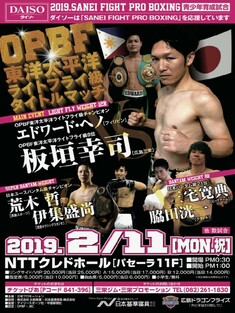 On February 11th fight fans in Hiroshima will get the chance to see a popular local fighter challenger for an OPBF title, in what is a real must win for the local, and the next stepping stone in the career of the champion. The champion in question is 26 year old Filipino Edward Heno (13-0-5, 5), the current OPBF Light Flyweight champion who will be taking on 35 year old challenger Koji Itagaki (18-13-3, 7). Another loss for Itagaki almost certainly ends his career, which began in 2005, whilst a win would be his defining achievement, and a huge upset. A win for Heno however would enhance his reputation and move him one more step towards a world title fight, in one of the sports most packed divisions. Heno won the title in September 2017, travelling to Japan and stopping Seita Ogido. Prior to winning the belt he had stopped the then 12-0 Cris Ganoza and been held to a very controversial draw with Ogido, having originally been announced as the winner before a scoring error was discovered. Since winning the title he has defended it against Merlito Sabillo and Jesse Espinas. In recent years Heno has proven to be a very talented boxer, with underrated power, a lot of confidence and a willingness to travel to prove himself, having travelled for both the bouts with Ogido and the bout with Sabillo. In the ring he's an accurate, sharp puncher, with smart defense and the ability to pick some fantastic counters. There's definitely areas to improve and work, but on the whole he's a fantastic young fighter who is hungry to prove himself, before getting a world title fight. It's clear he doesn't just expect a title shot, but feels the need to earn it. Itagaki has had a number of notable chances in the last few years. In 2017 he lost to Kenichi Horikawa, in a bout for the WBO Asia Pacific Light Flyweight title, and in 2018 he lost to the then Japanese champion Tetsuya Hisada, before at the end of the year to Horikawa in a Japanese title eliminator. In fact coming into this bout he is 2-4-1 in his last 7, going back more than 3 years. Unfortunately for Itagaki his record is reflective of his career, and he is a "win some lose some" fighter, who has mixed with good fighters, losing to the likes of Horikawa, Hisada, Rey Loreto, Suguru Munraka, and Warlito Parrenas, but unfortunately come up short against almost everyone of note. Despite his failings against decent fighters Itagaki isn't actually a bad fighter. For an older fighter he's light on his feet and has good a lovely quick jab. Sadly though he's a light puncher, he has to work incredibly hard for success and struggles to get respect from opponents. He certainly has the skills to make life difficult for opponents, but if a fighter can cut the ring off, they can really get to him. Likewise against a young, talented fighter, like Heno, we suspect that Itagaki's lack of physicality will be his down fall. We rate Heno incredibly highly and we're expecting him to show why he is so well regarded in the sport. We're expecting to see him show his speed,timing and variety to neutralise the movement of Itagaki, and force a late stoppage over the veteran. Yes Itagaki will be awkward early on, but as the pressure comes from Heno he'll slow down, and eventually be broken down. We don't expect to see Heno just look win, but instead we expect him to win in a way that makes a statement and begins to open the door to potential world title fights in Japan against WBA "super" champion Hiroto Kyoguchi or WBC champion Kenshiro. |
Previews
Having canned the old "Full Schedule" of Asianboxing we have instead decided to concentrate more on the major bouts. This section, the "Preview" section will look at major bouts involving OPBF and national titles. Hopefully leading to a more informative style for, you the reader. Archives
October 2022
Categories
All
|
 RSS Feed
RSS Feed
